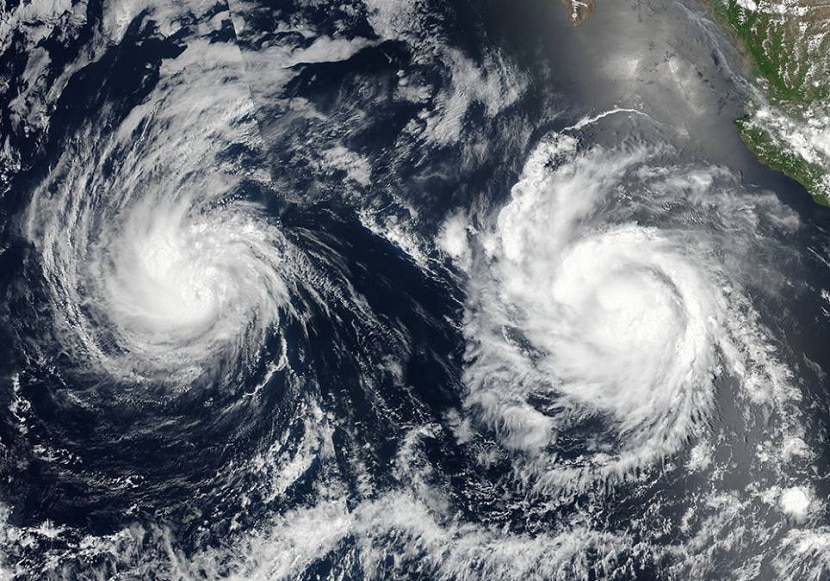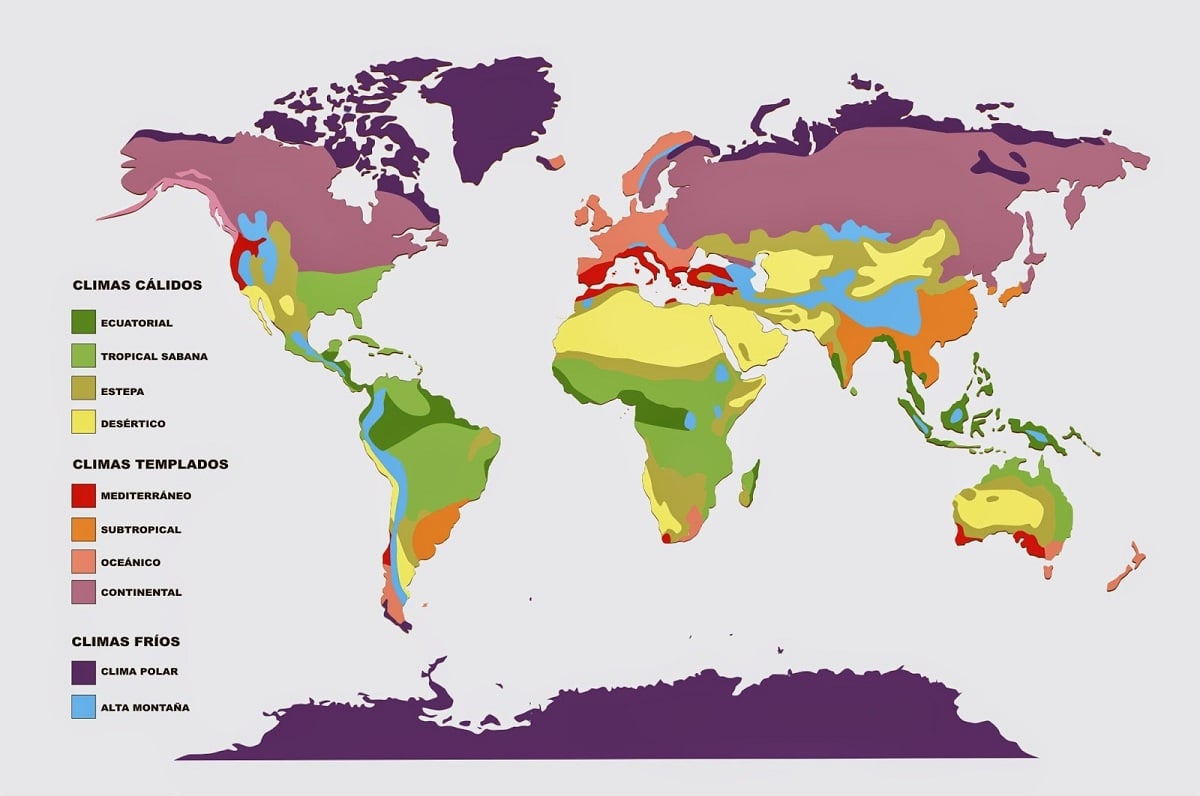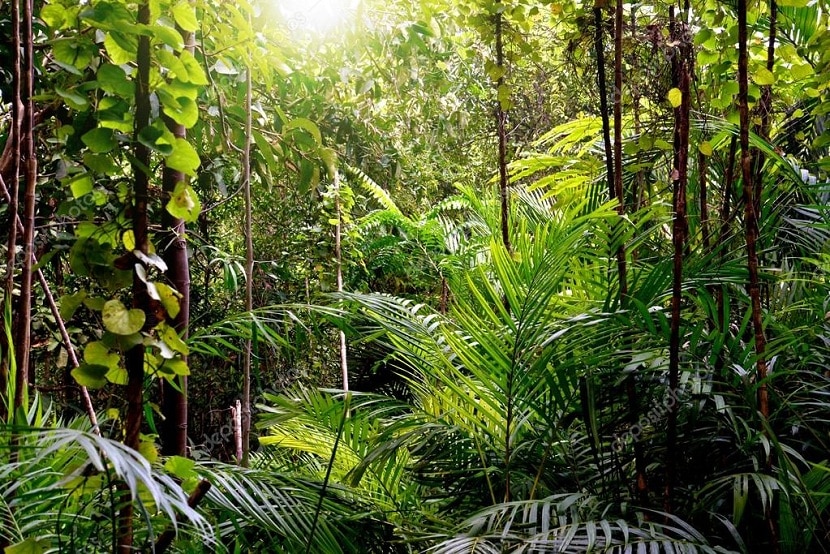
On our planet there are numerous types of different climates depending on the area where we find their characteristics. The world climates They can be divided according to their temperature, vegetation and prevailing meteorological phenomena. There are some factors to take into account this classification, so each of them must be studied in depth.
Therefore, we are going to dedicate this article to tell you what are the main climates in the world and what are their characteristics.
Climates of the world

Climate can be defined as a set of variable states that remain constant over time. Of course, you won't find anything with this sentence. We will explain it better in depth. The meteorological variables are temperature, precipitation (either rain or snow), stormy conditions, wind, atmospheric pressure, etc. Well, the set of all these variables has values throughout the calendar year.
All the values of the meteorological variables are recorded and can be analyzed because they are always close to the same threshold. For example, in Andalusia no temperature has been recorded below -30 degrees. This is because these temperature values do not correspond to the Mediterranean climate. Once all the data has been collected, the climate is divided into zones based on these values. The north pole is characterized by cold temperatures, strong winds, precipitation in the form of snow, etc. These characteristics make them called a polar climate.
Classification of the world's climates

The Earth's climate can not only be classified according to the meteorological variables mentioned above, but other factors are also involved, such as the altitude and latitude or distance of a place in relation to the ocean. In the following classification, we will broadly understand the types of climates that exist and the characteristics of each climate. Also, in each type of macroclimate, there are some more detailed subtypes that serve smaller areas.
Warm weather
These climates are characterized by high temperatures. The average annual temperature is around 20 degrees and there are only big differences between the seasons. They are places of prairies and forests, with high humidity and in many cases, abundant rains. There are different subtypes of hot climates. We are going to analyze what they are:
- Equatorial climate. As its name suggests, it is a climate that straddles the equator. Rainfall is generally abundant throughout the year, humidity is high, and the weather is always hot. They are distributed in the Amazon region, Central Africa, Indonesia, Madagascar and the Yucatan Peninsula.
- Tropical climate. It is similar to the previous climate, except that it extends to the tropical regions of Cancer and Capricorn. The only difference is that the rain here is only sufficient in summer. It can be found in the Caribbean, Venezuela, Colombia, Ecuador, Peru, some parts of South America, Southeast Asia, part of Australia, Polynesia, and Bolivia.
- Arid subtropical climate. This climate has a wide range of temperatures and rainfall varies throughout the year. It can be seen in southwestern North America, southwestern Africa, parts of South America, central Australia, and the Middle East.
- Desert and semi-desert. This climate is characterized by high temperatures throughout the year, and the difference in temperature between day and night is very evident. There is hardly any humidity, the vegetation and fauna are scarce and so is the rainfall. They are distributed in Central Asia, Mongolia, the Midwest of North America and Central Africa.
Temperate climates
They are characterized by an average temperature of about 15 degrees. In these climates, we can see that the seasons of the year vary greatly. We find that it is distributed between the middle latitudes 30 to 70 degrees from latitude. We have the following subtypes.
- Mediterranean climate. Among its main characteristics, we find that summer is very dry and sunny, while winter is rainy. We can find it in the Mediterranean, California, southern South Africa and southwestern Australia.
- Chinese weather. This climate has tropical cyclones and winter is very cold.
- Oceanic climate. It is a type that is found in all coastal areas. Under normal circumstances, there are always a lot of clouds and rain, although they do not have extreme temperatures in winter or summer. It is located on the Pacific coast, New Zealand, and parts of Chile and Argentina.
- Continental weather. This is the indoor climate. They appear in areas where there is no coastline. For this reason, they will heat up and cool down earlier because there is no sea as a heat regulator. This climate is mainly distributed in Central Europe and China, the United States, Alaska and Canada.
Cold climates
In these climatic conditions, the temperature does not usually exceed 10 degrees Celsius, and there will be a lot of precipitation in the form of ice and snow.
- Polar climate. This is the prevailing climate at the Earth's poles. It is characterized by very low temperatures throughout the year, and because the ground is permanently frozen, there is no vegetation.
- Alpine climate. It exists in all high mountain areas, and is characterized by abundant rains and the temperature decreases with height.
Importance of humidity

Humidity is an important factor in determining the capacity of an ecosystem to host diversity according to climate. In a dry climate annual precipitation is less than annual potential evapotranspiration. They are the climate of grasslands and deserts.
To determine if the climate is dry, we obtain a precipitation threshold in mm. To calculate the threshold, we multiply the annual mean temperature by 20, and then add if 70% or more of the precipitation falls in the semester where the sun is 280. The highest (April to September in the northern hemisphere, October to March in the southern hemisphere), or 140 times (if the precipitation in that period is between 30% and 70% of the total precipitation), or 0 times (if the period is between 30% and 70%) Precipitation is less than 30% of total precipitation.
As you can see, there are many climates in the world that exist. I hope that with this information you can learn more about the different climates of the world, what are their characteristics and classification.